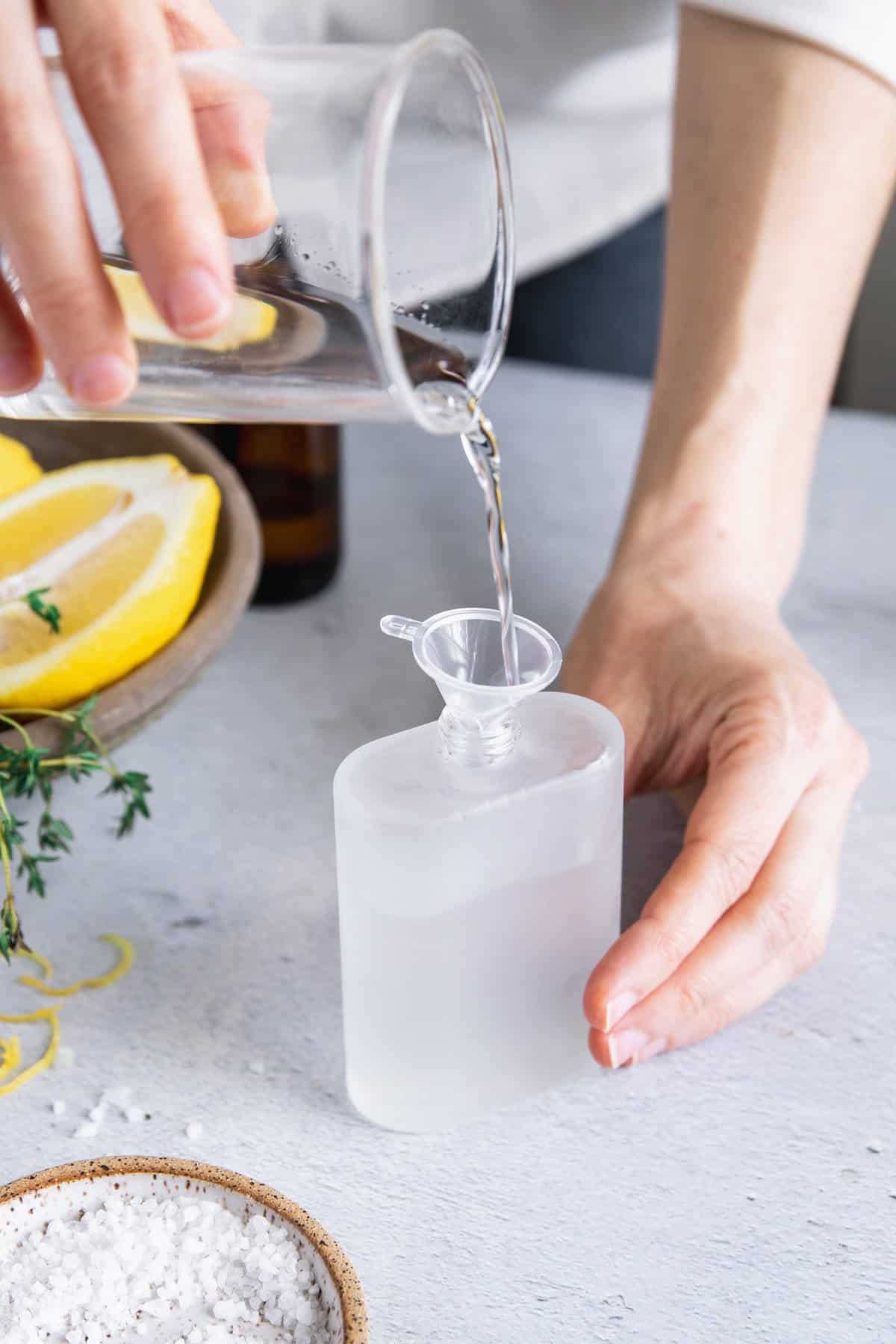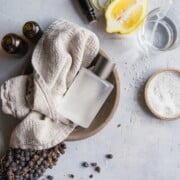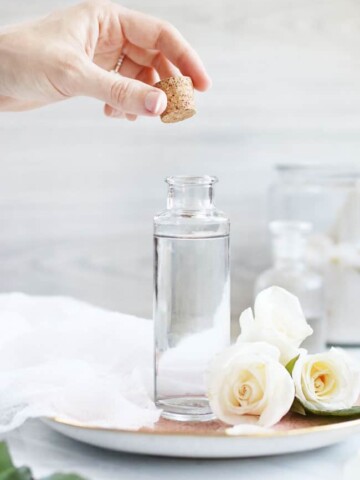It’s easy to turn your favorite essential oils into a custom scent that’s inexpensive and safe for daily use. Read on to learn how to make men’s cologne at home and customize it with a guy-friendly essential oil blend.

My husband used to never wear cologne so color me surprised when he recently started applying essential oils for, of all things, the scent. Turns out he’s not opposed to fragrance in general—just the overpowering, eye-watering scent of most store-bought colognes and body sprays.
Much like men's aftershave, men's cologne is a cinch to make at home. Round up these simple ingredients and start experimenting to find your signature scent.
Jump to:
Ingredients

Alcohol
Alcohol serves as the solvent in cologne, helping to disperse and dilute the essential oils. Alcohol also evaporates quickly, allowing the oils to linger on the skin and be released gradually over time.
Glycerin
Glycerin is a humectant, meaning it absorbs moisture from the air and holds it against the skin. In cologne, glycerin serves as a fixative, enhancing the longevity and staying power of the fragrance ever so slightly.
Plus, since alcohol can be pretty drying, glycerin adds a bit of moisture so that the skin feels soft and hydrated.
Water
Water dilutes the concentration of the essential oils and alcohol in the cologne mixture, resulting in a lighter, almost eau de toilette-like fragrance. This can be particularly useful if you prefer a subtler scent.
Water also slows the perfume's evaporation on your skin.
Essential Oil Perfume for Men
Essential oils are what give the cologne its fragrance. Since each essential oil has its own scent profile, whether it be floral, citrusy, earthy or spicy, when blended together, they create complex and layered fragrances that make a scent appealing.
I've left off the exact number of drops you'll need because you'll need to scale these blends up or down depending on personal preference and the size of your bottle.
1. Citrus Blends
If you love the scent of Calvin Klein's Eternity or Ralph Lauren's Polo Sport, try a refreshing citrus combination using lemon, lime, orange, or bergamot.
Herbal Citrus
- 3 parts lemon
- 2 parts rosemary
- 2 parts basil
Citrus Spice
- 3 parts bergamot
- 1-2 parts black pepper
2. Spicy Blends
Old Spice is a classic for a reason! The scents of nutmeg, cinnamon, cloves, and black pepper are still popular for men.
Sweet & Spicy
- 3 parts cardamom
- 2 parts clove
- 2 parts cinnamon
- 1 part orange
Leather & Spice
- 3 parts sandalwood
- 2 parts black pepper
- 2 parts ginger
3. Woody Blends
If you're partial to Aramis or Safari colognes, then try scents with deep, woody scents like vetiver, sandalwood, and cedarwood.
Woodsy
- 3 parts cedarwood
- 2 parts sandalwood
- 2 parts patchouli
Musky
- 2 parts frankincense
- 2 parts patchouli
- 1 part sandalwood
Earthy
- 1-2 parts vetiver
- 2 parts frankincense
- 2 parts myrrh
4. Green Blends
If you want to smell like you just took a walk in the woods, try oils like pine, juniper, rosemary, and rosemary. These blend well with lavender and woody scents.
Fresh Forest
- 3 parts pine
- 2 parts juniper berry
- 2 parts cypress
- 1 part grapefruit
Fresh Woods
- 2 parts cedarwood
- 1 part lavender
- 1 part rosemary
- 1 part orange
Instructions

Step 1: Prepare Your Essential Oil Blend
Start by selecting the oils you'd like to use in your cologne. If you're new to making cologne, begin with a simple recipe using just two, maybe three essential oils.
Over time you can add more oils. This will help you understand how different scents interact and give you a foundation for experimenting with more complex blends in the future.
10% blend: Add 10 ml of essential oil (about 200 drops) to a 100 ml bottle. If you're using liquid ounces, use 50-60 drops of essential oil per ounce of alcohol.
5% blend: Add 5 ml of essential oil (about 100 drops) to a 100 ml bottle. If you're using liquid ounces, use 25-30 drops of essential oil per ounce of alcohol.
Using a pipette, place the drops in a small glass bowl or a sanitized perfume bottle. We used a 100 ml cologne bottle but a 3-4 ounce bottle also works.

Step 2: Add a Small Amount of Alcohol + Adjust Scent
Once you've finalized your essential oil blend, it's time to combine it with alcohol. Using a pipette, add ¾ teaspoon alcohol to the oils.
Swirl gently to combine the oils with the alcohol. This ensures that the essential oils are evenly distributed and integrated into the alcohol base.
Make sure to give it a good sniff to see if you're still happy with the fragrance. If not, adjust the oils.

Step 3: Pour into Bottle + Add More Alcohol
If needed, transfer the oil and alcohol mixture to your chosen bottle. Pro tip: Using a funnel helps avoid spillage and keeps cleanup to a minimum.
Then add 2 oz (4 tbsp) of alcohol to the essential oil mixture.

Step 4: Add Water + Glycerin
If you're using distilled water, add it to the alcohol and essential oil mixture and fill the rest of the bottle. A common ratio is 2 parts alcohol to 1 part water, but you can adjust this based on your preference for strength.
If you don't want to add water, then fill the rest of the way with alcohol.
Finish by adding a few drops of glycerin to help anchor the fragrance and nourish your skin. Gently swirl or shake the bottle to incorporate it into the mixture.
Should I Let the Scent Age?
Most perfumers will say that you should let homemade cologne sit before using it, as this enhances the scent and allows the different fragrances to meld.
As a general rule of thumb, let your cologne mature for 1 to 2 weeks before using. This lighter version of perfume needs time for the essential oils to permeate the alcohol and water.
Equipment
In addition to the ingredients mentioned above, the formulation process goes a heck of a lot smoother with the help of a few specialized supplies.
Perfume Bottle: Perfume bottles come in various sizes, depending on your needs and preferences. The standard cologne bottle size is roughly 100 milliliters. But smaller sizes, like 30 ml or 50 ml bottles, are more portable and convenient for travel.
While you can use any spray bottle you like, perfume bottles are designed to release just the right amount of fragrance, so you're not drenched in cologne with each spritz.
Small Bowl or Glass: I recommend using a small bowl or glass for mixing the essential oils and testing the fragrance before pouring it into the perfume bottle. The wider opening allows you to smell different oil combinations, adjust the scent profile, and make sure you’re happy with it before diluting it with alcohol.
Small Funnel: A small, perfume bottle-sized funnel helps transfer the cologne mixture to the bottle. If you purchase an empty perfume bottle, a small funnel is typically included.
Pipette: A pipette is a small, slender tube with a narrow opening at one end used for transferring small quantities of liquids, such as essential oils. When making cologne, a pipette is essential for accurately measuring and dispensing the precise number of drops of each essential oil into the mixture.

FAQ
Yes, one of the main advantages of making cologne is the ability to customize the scent to your preferences. This post walks you through the process of experimenting with different essential oil combinations to make your own unique fragrances.
The shelf life of homemade cologne can vary depending on the ingredients used and how it's stored. Typically, homemade fragrances can last anywhere from 6 months to a few years if stored in a cool, dark place away from sunlight and heat. However, if you add water to your cologne, the shelf life may only be around 2-3 months.
While it can be challenging to replicate complex designer fragrances exactly, you can certainly create inspired versions using similar scent profiles and ingredients. Experimenting with different essential oil combinations can help you achieve a fragrance reminiscent of your favorite designer scent.
Yes, you can make alcohol-free versions of cologne or perfume using only carrier oil and essential oils. However, alcohol is often used as a solvent to help blend the oils and create a longer-lasting fragrance.
How To Make Men's Cologne with Essential Oils
Equipment
- Small bowl or glass jar
- Mini funnel for perfume bottle
Materials
- 10 ml essential oil
- 60 ml perfumer's alcohol or grain alcohol
- 30 ml distilled water
- 5 drops glycerin
- Distilled water to make more of an Eau de Toilette (optional)
Instructions
- Prepare your essential oil blend by combining the desired essential oils in a bowl or perfume bottle. Adjust the ratio of oils to your preference by adding more or less of each oil.
- Add a small amount of alcohol to the essential oil blend.
- Swirl to combine the oils with the alcohol thoroughly. This step ensures that the essential oils are evenly distributed and integrated into the alcohol base. Smell the fragrance again to make sure it's still to your liking. If not, add more oils.
- Using a funnel, pour into a cologne bottle and add 60 ml (2 oz) of alcohol then fill the rest of the way with distilled water. If you want to skip the distilled water, just add more alcohol.
- Add 5 drops glycerin to improve the longevity of your scent. If you'd like to dilute your fragrance so it's not as strong, add a little water as well.
- Let the cologne rest for anywhere between 24 hours and 2 weeks. As it matures, the scent may change slightly as the oils meld.






Leave a Comment